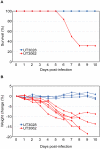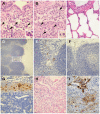The HA and NS genes of human H5N1 influenza A virus contribute to high virulence in ferrets
- PMID: 20862325
- PMCID: PMC2940759
- DOI: 10.1371/journal.ppat.1001106
The HA and NS genes of human H5N1 influenza A virus contribute to high virulence in ferrets
Abstract
Highly pathogenic H5N1 influenza A viruses have spread across Asia, Europe, and Africa. More than 500 cases of H5N1 virus infection in humans, with a high lethality rate, have been reported. To understand the molecular basis for the high virulence of H5N1 viruses in mammals, we tested the virulence in ferrets of several H5N1 viruses isolated from humans and found A/Vietnam/UT3062/04 (UT3062) to be the most virulent and A/Vietnam/UT3028/03 (UT3028) to be avirulent in this animal model. We then generated a series of reassortant viruses between the two viruses and assessed their virulence in ferrets. All of the viruses that possessed both the UT3062 hemagglutinin (HA) and nonstructural protein (NS) genes were highly virulent. By contrast, all those possessing the UT3028 HA or NS genes were attenuated in ferrets. These results demonstrate that the HA and NS genes are responsible for the difference in virulence in ferrets between the two viruses. Amino acid differences were identified at position 134 of HA, at positions 200 and 205 of NS1, and at positions 47 and 51 of NS2. We found that the residue at position 134 of HA alters the receptor-binding property of the virus, as measured by viral elution from erythrocytes. Further, both of the residues at positions 200 and 205 of NS1 contributed to enhanced type I interferon (IFN) antagonistic activity. These findings further our understanding of the determinants of pathogenicity of H5N1 viruses in mammals.
Conflict of interest statement
The authors have declared that no competing interests exist.
Figures






References
-
- Claas E, Osterhaus A, van Beek R, De Jong J, Rimmelzwaan G, et al. Human influenza A H5N1 virus related to a highly pathogenic avian influenza virus. Lancet. 1998;351:472–477. - PubMed
-
- Subbarao K, Klimov A, Katz J, Regnery H, Lim W, et al. Characterization of an avian influenza A (H5N1) virus isolated from a child with a fatal respiratory illness. Science. 1998;279:393–396. - PubMed
-
- Hatta M, Gao P, Halfmann P, Kawaoka Y. Molecular basis for high virulence of Hong Kong H5N1 influenza A viruses. Science. 2001;293:1840–1842. - PubMed
Publication types
MeSH terms
Substances
LinkOut - more resources
Full Text Sources
Other Literature Sources
Medical
Miscellaneous

